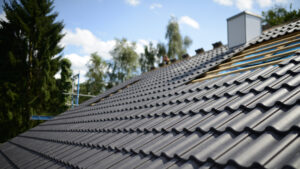Tile Roofing: Advantages and Drawbacks

*Updated September 3rd, 2025
When it comes to protecting your home from the elements, few decisions are as important as choosing the right roofing material. With the wide range of available roofing options, it can be challenging to determine which one best suits your needs. One popular choice among homeowners is the tile roof.
In fact, a recent survey cited by the Tile Roofing Industry Alliance found that nearly 30% of new homes in the United States feature some form of roof tile. But what exactly makes this material so appealing, and are there any potential downsides to consider? In this article, we’ll take an in-depth look at the pros and cons of tile roofing to help you make an informed decision for your home.
Understanding Roofing Tiles
Before we dive into the advantages and disadvantages of tile roofing, let’s first define what we mean by “roofing tiles.” These are individual units, typically made from clay roof tile, concrete roof tile, or slate tile, installed in an overlapping pattern to create a watertight seal on your roof structure. Roof tiles are made from a variety of materials, and roof tiles come in a wide range of styles and finishes.
Clay and concrete roofs have been used for centuries, with some ancient structures still sporting their original clay tile roofs. Today, advances in manufacturing from major tile manufacturers like Eagle Roofing Products and Ludowici Roof Tile have led to a wide variety of tile products, colors, shapes, and textures. That versatility makes tile roofing a solid choice for many homeowners.
The Benefits of a Tile Roof
1. Unmatched Durability
With proper tile roof installation and maintenance, a concrete tile roof or clay tile roof can last 50 to 100 years, far outlasting common roofing materials like asphalt shingles or a shingle roof. This longevity is one reason roofing contractors often recommend a tile roof to homeowners looking for long-term value.
2. Excellent Weather Resistance
Tile roofing offers impressive resilience against hail, wind, rain, and even fire. Clay or concrete tiles in particular are designed to handle the heat from wildfires or the cold stress of snow. Specialty options like barrel tile, mission tile, and pantiles are semi-cylindrical in design, helping water run off easily.
3. Energy Efficiency
A major advantage of a tile roof is reduced energy costs. The air gaps beneath concrete tiles or clay tiles act as insulation, keeping homes cooler in the summer and warmer in the winter. Options like solar roof tiles and solar tiles can also generate renewable energy, further lowering energy bills.
4. Low Maintenance Requirements
Unlike wood shingle or wood shake roofs that can rot or warp, clay roof tiles, slate roof tiles, and composite roof tiles are more resistant to pests, decay, and weather. Occasional cleaning to remove moss or algae buildup is usually enough, making it a low-maintenance roofing system.
5. Design Versatility
From rustic Spanish tiles to modern metal roof tiles that mimic slate or shake roof tiles, roof tile options fit nearly every home style. Homeowners can choose from a variety of color and finishes, including tiles with a glaze or taper for added shine and detail. Products like Brava Roof Tile and synthetic tiles even replicate the look of slate or wood while remaining lightweight.
The Drawbacks of a Tile Roof
1. Heavyweight and Structural Needs
Concrete roof tiles and clay roof tiles can weigh several hundred pounds per square, meaning the roof structure must be reinforced to handle the weight. Homes with flat or lightweight designs may require modifications before installing tile.
2. Higher Upfront Costs
Compared to traditional roofing materials like asphalt shingles, tile roofs come with higher upfront costs. However, their longevity makes them a better investment in the long term.
3. Complex Installation
Installing tile is not a DIY project. Only experienced roofing crews should handle the job, as improper installation can compromise the roofing system. Specialty knowledge is required for products like interlocking roof tiles or unique shapes like Scandia tiles.
4. Potential for Breakage
Although durable, roof tiles are available in brittle materials like clay and slate that can crack under heavy impact. Hail, falling branches, or foot traffic can damage slate tile roofs or clay roof tiles, requiring spot replacement.
5. Maintenance Considerations
While relatively low-maintenance, a tile roof still needs cleaning in shady or humid areas to prevent algae. Broken tiles—whether synthetic roof or traditional clay—must be replaced promptly to avoid leaks.
Exploring Popular Roof Tile Types
-
Clay Roof Tile – Traditional, fired clay, available in flat tiles, pantiles, and classic barrel tile designs. Clay tiles last for decades with minimal care.
-
Concrete Roof Tile – Affordable alternative to clay, with options that mimic wood, slate, or composite tiles. Often used by brands like Eagle Roofing.
-
Slate Roof Tiles – Premium roof tile types that offer unmatched beauty and can last over a century. Perfect for upscale or historic homes.
-
Metal Roof Tiles – Lightweight roofing products that mimic slate, shake, or wood shingle. Popular in areas with salt air or extreme weather.
-
Solar Roof Tiles – Innovative roofing products that double as solar panels, reducing energy costs while blending with your roof style.
Choosing the Right Roof Tile Options for Your Home
When selecting the best tile roof for your home, consider:
-
Climate: A clay tile roof resists heat well, while a slate roof or composite roof tiles may be better in wet regions.
-
Home style: Match your tile to your home style, whether modern, Mediterranean, or rustic.
-
Budget: Account for upfront costs versus long-term savings.
-
Maintenance: Different tiles require different care.
-
Sustainability: Options like synthetic tiles or solar roof tiles can lower environmental impact.
Frequently Asked Questions
How much does a tile roof cost?
Costs vary, but most homeowners spend $10–$30 per square foot, depending on the materials used and the number of tiles required.
Can I walk on my tile roof?
It’s best to avoid it. Even strong concrete tiles or slate tiles can crack. Always hire roofing contractors for inspections.
How long does a tile roof last?
A properly installed concrete tile roof or clay tile roof can last over 50 years, while slate tile roofs may last a century or more.
Are tile roofs energy-efficient?
Yes—roof tiles naturally insulate and can reduce energy costs. Some even feature reflective coatings or integrate with solar tiles.
How do I maintain my tile roof?
Hire an experienced roofing professional for inspections, clean debris to prevent algae, and replace broken tiles quickly. Avoid walking directly on roof tiles whenever possible.
Conclusion
Tile roofing offers a unique blend of style, longevity, and performance. From clay roof tiles and concrete roof tiles to innovative solar roof tiles, there’s a solution for nearly every homeowner’s needs. While the weight and upfront costs are worth considering, the durability, design versatility, and lower lifetime energy costs make a tile roof one of the most valuable roofing options available today.
With the right tile roof installation and care, your new roof can provide lasting beauty and protection—making it a smart investment for any homeowner.
Additional Roofing Resources
- Choosing the Best Roof Coating for Your Home
- The Dangers of DIY Roof Repairs
- Do You Need a Drip Edge on Your Roof?
- Choosing the Best Roof Material for Your Coastal Home

Anna has over six years of experience in the home services and journalism industries and serves as the Content Manager at MyHomePros.com, specializing in making complex home improvement topics like HVAC, roofing, and plumbing accessible to all. With a bachelor’s degree in journalism from Auburn University, she excels in crafting localized, comprehensive guides that cater to homeowners’ unique needs. Living on both coasts of the United States has equipped her with a distinctive perspective, fueling her passion for turning any house into a cherished home through informed, personalized decision-making.








